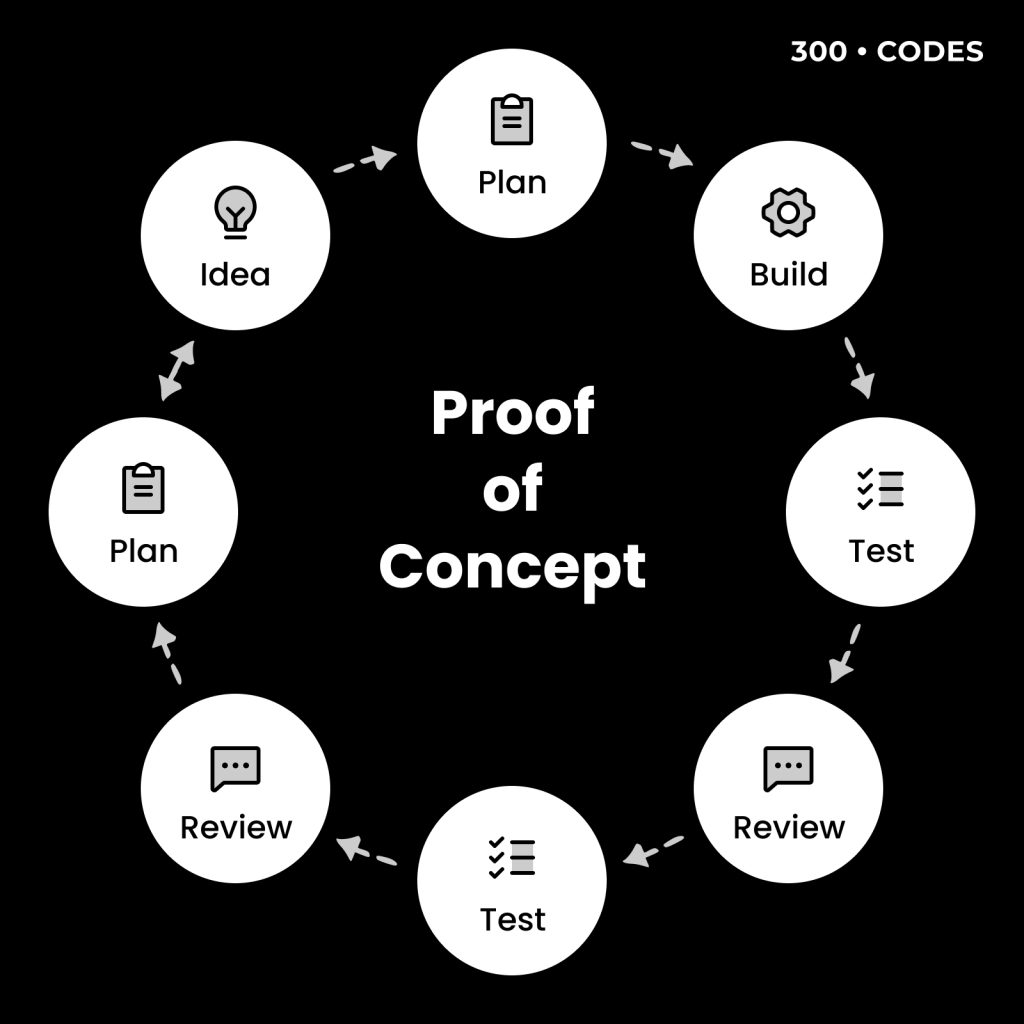Proof of Concept (PoC) in Software Development: A Beginner’s Guide
Publication date: 29.01.2024
Last updated: 29.01.2024

Welcome to the world of software development! If you’re new here, you might have heard the term “Proof of Concept” (PoC) and wondered what it’s all about. This guide is designed to help you understand PoC simply and straightforwardly. Whether you’re a client or just curious about software development, this guide will provide you with the essential knowledge you need.
A Proof of Concept – Definition
A Proof of Concept in software development is essentially a small project used to test the feasibility of a certain idea or method. Think of it like a prototype, but instead of testing if a product works, a PoC tests if a concept or theory can be applied in a real-world scenario. The main goal is to determine the potential success of the idea before investing significant time and resources into full-scale development.
A PoC typically focuses on:
- Technical Feasibility: Does the concept work technically? Can it be developed with the current technological and resource constraints?
- Real-world Applicability: Beyond technical feasibility, can this concept be applied in a practical, real-word environment to meet specific needs?
- Scalability and Sustainability: If the concept proves viable, can it be scaled up? Is it sustainable in the long run within the market and industry?
The Benefits of a PoC in Software Development
- Risk Mitigation: A PoC helps in identifying potential issues early, reducing the risk of costly failures later. However, underestimating the complexity of the PoC can lead to oversimplification, which might not accurately represent the challenges of a full-scale project.
- Cost Efficiency: While a PoC is cost-effective, improper budgeting of resource allocation can escalate costs, diminishing its value. It’s crucial to have a well-defined scope to prevent resource drainage.
- Stakeholder Confidence: A successful PoC can garner stakeholder trust. Conversely, a poorly executed PoC, which doesn’t align with the project’s core goals, can lead to mistrust and skepticism.
- Clarity and Direction: A well-executed PoC provides clarity and direction for the project. However, if the objectives of the PoC are not aligned with the final product goals, it can lead to misguided conclusions.
How to Create the Proof of Concept
Step 1: Idea Clarification:
Objective: Define the specific aspect or feature of the project you want to test.
Pitfalls to avoid:
- Overambitious Scope: Setting an unrealistically broad or complex scope for the PoC can lead to inconclusive or misleading results. It’s vital to focus on a manageable and critical aspect of the project.
- Misalignment with Business Goals: If the PoC idea doesn’t align with the overall business objectives or market needs, it may result in a technically successful but commercially irrelevant outcome.
Step 2: Resource Allocation:
Objective: Determine the team, tools, technology, and time required for the PoC.
Pitfalls to avoid:
- Inadequate Skill Set: Failing to involve team members with the necessary skills and expertise can compromise the quality and reliability of the PoC.
- Ignoring Time Constraints: Underestimating the time required to complete the PoC can lead to rushed development and testing, impacting the accuracy of the results.
Step 3: Development Phase:
Objective: Building the PoC, focusing on the primary objective and keeping it as simple as possible.
Pitfalls to avoid:
- Lack of Documentation: Neglecting to document the development process, assumptions, and modifications made during the PoC can create challenges in scaling the project and replicating results.
- Technology Misfit: Using technologies or tools that are not suited for the full-scale project can give a false sense of feasibility or performance in the PoC.
Step 4: Testing and Evaluation:
Objective: Rigorously test the PoC for functionality and feasibility.
Pitfalls to avoid:
- Biased Testing Environment: Testing the PoC in an environment that does not accurately reflect the real-world scenario for which the product is intended can skew results.
- Inadequate Success Criteria: Failing to define clear, measurable success criteria before testing can make it difficult to objectively assess the PoC’s effectiveness and make informed decisions.
Step 5: Decision Making:
Objective: Use the insights from testing to decide on the next steps.
Pitfalls to avoid:
- Resistance to Change: Being overly invested in the initial idea can lead to ignoring critical feedback or test results, pushing forward with a flawed concept.
- Lack of Stakeholder Involvement: Failure to involve or consider the perspectives of all key stakeholders in the decision-making process can lead to decisions that do not take into account important user or business needs.
Proof of Concept Examples
Let’s look at some hypothetical examples to better understand PoCs:
- E-commerce Chatbot:
Consider an e-commerce company looking to enhance customer service through a chatbot. Before implementing this on a large scale, a PoC is developed to test the chatbot’s ability to handle customer inquiries and integrate with existing systems. This PoC helps determine the chatbot’s effectiveness and usability, providing valuable insights into its potential impact on customer satisfaction and service efficiency. - Mobile Payment System:
A financial institution exploring the launch of a mobile payment app would first develop a PoC. This PoC would focus on the app’s security features, ease of use, and integration with existing banking systems. By testing these aspects on a small scale, the institution can identify and address any security vulnerabilities and usability issues before a full-scale launch. - Remote Work Collaboration Tool:
In the era of remote work, a tech company plans to develop a collaboration tool. The PoC for this tool would test key features like video conferencing, document sharing, and real-time chat. By assessing the tool’s performance with a small group of remote workers, the company can gauge its usability, reliability, and acceptance, which are crucial for a tool designed for widespread use in various remote working environments.
To further illustrate these concepts, let’s include a simple diagram that shows the process of developing a PoC in software development:

Remember, understanding the concept of a PoC is essential in the field of software development. A Proof of Concept is not just a preliminary step; it’s a strategic tool that bridges the gap between an innovative idea and its practical application and helps you understand the viability of your ideas in a real-world context. Happy innovating!



